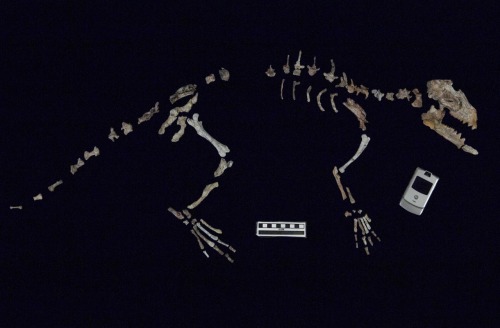dailyfossil:Indohyus Reconstruction by Carl Buell. When: Eocene (~48 million years old) Where: Ind
dailyfossil: Indohyus Reconstruction by Carl Buell. When: Eocene (~48 million years old) Where: India and Pakistan What: Indohyus is a fossil artiodactyl that falls on the lineage leading to whales. The discovery of an almost complete specimen Indohyus helped to answer one of the long standing questions in the early evolution of whales. All living whales are carnivorous (with diets ranging from vertebrate prey to tiny invertebrates), however, all other living artiodactyls are predominately herbivorous. As all fossils assuredly related to whales showed both aquatic and carnivorous adaptations, it was a mystery as to which came first in the evolution of the cetaceans. Enter Indohyus. This fossil lacks any carnivorous adaptions in its dentition, but has several adaptations for spending time submerged - most notable are an ear region that looks a lot like that of previously known fossil whale ancestors and bones with increased density. These features would have allowed the animal to hear better underwater and to stay submerged easier, respectively. Isotopic analysis of its dentition and bones suggests that Indohyus spent a good amount of time in waters, but fed on land plants - much like the modern Hippopotomus. It has been suggested Indohyus fled to the water to avoid predators, like the modern African Mousedeer, which has been documented spending almost five minutes underwater to escape predation. Indohyus was about 3 feet (~1 meter) long from end to end, thus it would have had many potential predators in the early Eocene world. Phylogenetic analysis place Indohyus at the base of what have traditionally been referred to as ‘archaeocetes’; a paraphyletic lineage of fossils more closely related to whales than to hippos. The term Cetaceamorpha is used for the group that includes all living whales and all fossils more closely related to them than to the hippos. Falling very near Indohyus is an animal called Diacodexis. I will highlight this animal more in a future entry, but to be brief it shows none of the aquatic adaptions of Indohyus, but has simular dentition. Thus, the current hypothesis of basal whale evolution is that small deer-like animals first went into the water, possibly for protection from predators, and then later became carnivorous. -- source link
#indohyus#raoellid

